
Baron Sir Ferdinand Jacob Heinrich von Mueller, was a German-Australian physician, geographer, and most notably, a botanist. He was appointed government botanist for the then colony of Victoria (Australia) by Governor Charles La Trobe in 1853, and later director of the Royal Botanic Gardens, Melbourne. He also founded the National Herbarium of Victoria. He named many Australian plants.

Swainsona is a genus of about 85 species of flowering plants in the family Fabaceae, and is endemic to Australia. Plants in this genus are herbs or subshrubs with imparipinnate leaves and usually purple flowers similar to others in the family.
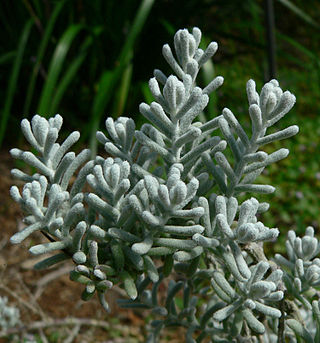
Maireana sedifolia, also known as the bluebush or pearl bluebrush is a compact shrub endemic to Australia, and found in New South Wales, Victoria, South Australia, Western Australia, and the Northern Territory. It is used in pasture and as a garden plant where it is popular due to its distinctive grey foliage.
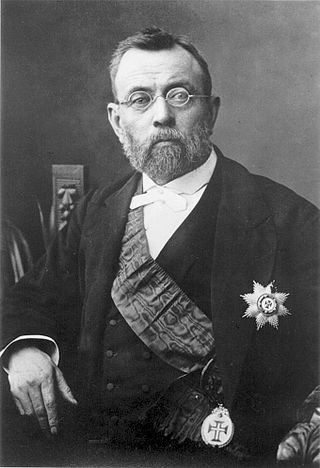
Fragmenta phytographiae Australiae is a series of papers written by the Victorian Government botanist Ferdinand von Mueller in which he published many of his approximately 2000 descriptions of new taxa of Australian plants. Including the plant genera of; Reedia, and Acomis . The papers were issued in 94 parts between 1858 and 1882 and published in 11 volumes. Though a 12th volume was apparently planned, it was not published. It is the only scientific periodical in Australia that has been completely written in Latin.

Xanthosia atkinsoniana, is a small herb in the family Apiaceae. It grows in both New South Wales and Western Australia.
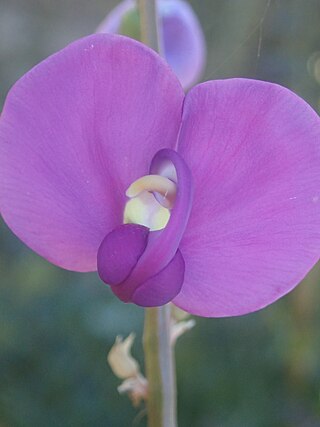
Swainsona procumbens is a plant in the pea family (Fabaceae) native to Australia and found in New South Wales, Victoria, Queensland and South Australia.
Asteridea croniniana is a herb in the Asteraceae family, which is endemic to Western Australia. It is an annual herb, growing to a height of 8 cm.

Pembertonia latisquamea is a species of daisy (Asteraceae), native to Western Australia. It was first described by Ferdinand von Mueller in 1878 as Brachyscome latisquamea and transferred to the genus, Pembertonia in 2004 by Philip Short.

Styphelia allittii is a species of flowering plant in the family Ericaceae and is endemic to the south-west of Western Australia. It is a rigid, glabrous shrub that typically grows to a height of about 30 cm (12 in) and has egg-shaped or lance-shaped leaves and tube-shaped, white flowers.

Styphelia breviflora is a species of flowering plant in the heath family Ericaceae and is endemic to the south-west of Western Australia. It is an erect, spindly, glabrous shrub that typically grows to a height of up to about 1.5 m. It has oblong to lance-shaped or linear leaves 4–9 mm (0.16–0.35 in) long on a short petiole and with a small, rigid point on the tip. The flowers are borne singly or in pairs in leaf axils on a short peduncle with small bracts and bracteoles about half as long as the sepals. The sepals are about 2 mm (0.079 in) long and the petals white and about 4 mm (0.16 in) long, the petal lobes longer than the petal tube.

Sclerolaena eurotioides is a species of flowering plant in the family Amaranthaceae, native to Western Australia. It was first described in 1869 by Ferdinand von Mueller as Echinopsilon eurotioides, but was transferred to the genus, Sclerolaena in 1978 by Andrew John Scott.
Stenanthemum complicatum is a species of flowering plant in the family Rhamnaceae and is endemic to the southwest of Western Australia. It is a woody, erect or straggling shrub with densely hairy young stems, broadly egg-shaped leaves and densely woolly-hairy heads of tube-shaped flowers.
Stenanthemum divaricatum is a species of flowering plant in the family Rhamnaceae and is endemic to the southwest of Western Australia. It is a small, often spiny shrub with sparsely hairy young stems, fan-shaped to narrowly egg-shaped leaves and densely, softly-hairy heads of tube-shaped flowers.
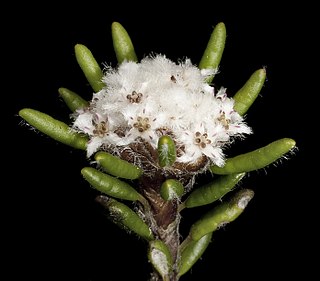
Stenanthemum humile is a species of flowering plant in the family Rhamnaceae and is endemic to the southwest of Western Australia. It is a low, erect perennial herb or shrub with white, woolly-hairy young stems, linear to narrowly elliptic leaves and densely, woolly-hairy heads of tube-shaped flowers.

Swainsona colutoides, commonly known as bladder senna or bladder vetch, is a species of flowering plant in the family Fabaceae and is endemic to arid areas of Australia. It is an erect annual, shrub-like herb, with imparipinnate leaves usually with up to 13 to 17 egg-shaped leaflets with the narrower end towards the base, and racemes of 10 to 20 purple flowers.

Swainsona maccullochiana, commonly known as Ashburton pea, is a species of flowering plant in the family Fabaceae. It is an upright annual with purple-reddish, pink or bluish pea-like flowers from spring to summer and is endemic to Western Australia.
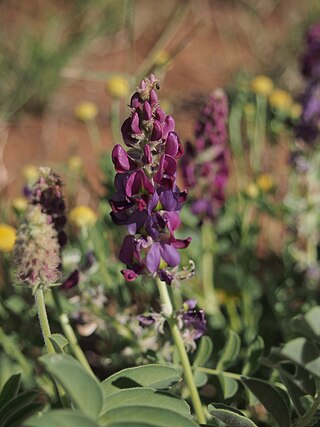
Swainsona canescens, commonly known as grey swainsona, is a flowering plant in the family Fabaceae. It is a small perennial herb with pink-purple or purple, yellow and green flowers and grows in Queensland, Western Australia and South Australia.

Swainsona beasleyana is a species of flowering plant in the family Fabaceae and is endemic to inland areas of Western Australia. It is a low-lying perennial herb with imparipinnate leaves usually with 15 to 19 egg-shaped leaflets with the narrower end towards the base, and racemes of 3 to 8 pale or dark purple flowers.

Swainsona campylantha, commonly known as Gilgai Darling pea, is a species of flowering plant in the family Fabaceae and is endemic to inland areas of Australia. It is a low-growing perennial with imparipinnate leaves usually with up to 7 narrowly lance-shaped to narrowly elliptic leaflets, and racemes of 2 to 10 pink to purple flowers.
Swainsona cyclocarpa is a species of flowering plant in the family Fabaceae and is endemic to northern inland areas of Australia. It is a prostrate or low-growing annual with imparipinnate leaves usually with up to 7 usually egg-shaped leaflets with the narrower end towards the base, and racemes of 4 to 16 purple flowers.















